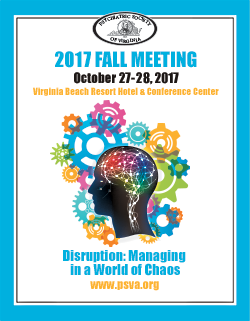Summer 2017 Issue |
|
The Opioid Epidemic
Brent McCraw, MEd
Director, Pathways Addiction & Recovery Services
Centra Health
Deaths from opioid overdoses are skyrocketing across America. An estimated 44 Americans die every day from prescription opioid and heroin overdoses, and at least two of them occur in Virginia. The Centers for Disease Control and Prevention (CDC) has labeled prescription drug abuse an “epidemic” in America with prescription opioid overdoses more than quadrupling since 2000. CDC researchers estimate that 28,647 drug overdose deaths in 2014 in the United States involved some type of opioid, including heroin.
Non-fatal opioid overdoses that require medical care in a hospital or emergency department are even more prevalent, with the number of such events increasing by a factor of six in the past 15 years, according to the CDC.
Virginia has not escaped the opioid crisis. In 2014, the Virginia Department of Health reports 733 Virginians lost their lives to opiate overdoses — a 38 percent increase in fatalities since 2012. And in 2014, for the first time, prescription opioid and heroin overdoses killed more Virginians than automobile accidents.
According to Virginia Commonwealth University School of Medicine, prescription opiate deaths are concentrated in Southside, the Shenandoah Valley, Southwest Virginia, Hampton Roads, Metro Richmond and Northern Virginia. Deaths from heroin overdoses are highest in the Shenandoah Valley, Hampton Roads, Metro Richmond and Northern Virginia.
An estimated 30 to 40 percent of Americans are reported to suffer from acute or chronic pain. A decade ago, the healthcare industry made a major effort to better manage chronic pain’s disabling effects, causing opioid analgesics, including oxycodone and hydrocodone, to become the most commonly prescribed class of medications in the United States. The CDC reports that in 2012 alone, 259 million prescriptions were written for opioids—more than enough to give every American adult his own bottle of pills.
This greater availability of prescription opioids has been a contributing factor to today’s opioid epidemic. These pain relievers present an intrinsic abuse and addiction liability because they are similar to, and act on the same brain systems affected by, heroin and morphine. Well-intentioned treatment for pain has triggered addiction in people who may have been genetically disposed to dependency.
With prescription opioids flooding the marketplace, many are diverted to family or friends who are often unaware of the dangers of nonmedical use. In addition, opioids are often stolen from medicine cabinets and sold on the street.
A second contributing factor to today’s opioid/heroin epidemic is the reintroduction of heroin in a different form – that which can be smoked or snorted. Two or three decades ago, heroin use was solely by intravenous injection. The known risk of serious, long-term viral infections such as HIV, Hepatitis C, and Hepatitis B, as well as bacterial infections of the skin, bloodstream and heart, kept many people away. The easier administration of heroin has changed all that, with its use more than doubling among young adults, ages 18-25, in the past decade.
A certain percentage of heroin abusers began with a legitimate prescription for painkillers, became addicted, but were no longer able to get opioids because their health was better or they were abusing their prescriptions. They had to find another source for their addiction, and that source was heroin. At least half of the patients who are in treatment for heroin addiction at Pathways Addiction & Recovery Services began with opioids prescribed for pain from sports injuries, car accidents, surgery or other legitimate medical reasons.
Overdose Deaths
Although the 4.5 million Americans who admit to nonmedical use of prescription pain medications and the 289,000 who admit to heroin use do not compare to the 61.6 million Americans who are binge or heavy drinkers, the alarming number of opioid overdose deaths has brought the opioid crisis to the national forefront.
Why are people dying? Opioids, when used repeatedly over time, induce tolerance – a physiological change that requires a higher dose of the same substance to achieve the same effect. With opioid dependency, the tolerance reverses very rapidly, which contributes to a greater risk of an overdose death during a relapse to opioid use after a period of abstinence. Opioid users who do not realize they have lost their tolerance may use the same amount as they did before a recovery period, overdose and die.
The risk of dying from a heroin overdose has increased further by contamination with other drugs such as fentanyl, a potent prescription opioid by itself. From 2001 to 2014, there was a six-fold increase in the total number of overdose deaths from heroin, reports the National Institute on Drug Abuse.
Physicians across the country are working to manage patients’ pain with alternatives to oxycodone and hydrocodone. Many emergency departments have a policy limiting access to prescription opioids. Patients in treatment centers like Pathways are being warned of the serious risk of overdose death if they relapse after treatment. And hospitals, such as Centra Virginia Baptist Hospital, are stabilizing and minimizing the withdrawal effects of opioid dependent pregnant mothers and their newborns.
With the growing body of research supporting medication assisted treatment, Pathways and other treatment centers also have better ways to manage withdrawal and cravings from opioid dependence. Examples of medication assisted treatment include suboxone, naltrexone and methodone (only in licensed opioid treatment programs). Methodone assisted treatment always includes counseling and support.
Friends and family members of opiate and heroin abusers also are being educated about the life-saving drug naloxone, which reverses the effects of opioid overdoses. The non-addictive medication is administered through nasal spray or auto-injector. Naloxone is becoming more readily available and can be purchased without a prescription in pharmacies such as CVS.
Communities across the country can have an impact on this epidemic by raising awareness, reducing the stigma associated with addiction, educating young people about the risks associated with opioid and heroin abuse, and changing prescribing patterns to reduce the availability of pharmaceutical opioids.
This article originally appeared in Centra’s Mental Health Matters in 2016. For more information about Pathways Addiction & Recovery Services, visit: RecoverAtPathways.com.
Brent McCraw, MEd currently lives in Lynchburg with his wife and son and twin daughters. He has worked for Centra Health for twenty years.
YOUR NEWSLETTER IS NOW AVAILABLE ON YOUR SMARTPHONE AND TABLET!
JOIN PSV TODAY!
REGISTER TODAY!
PSV 2017
FALL MEETING
October 27-28, 2017
Virginia Beach Resort Hotel
& Conference Center
Virginia Beach, Virginia
MARK YOUR CALENDAR!
APA Find a Psychiatrist
Are you accepting new patients?
Opt into APA’s “Find A Psychiatrist” database. To view the functionality or opt-in, CLICK HERE
FYI: A link for this option has been added to the PSV website so the public can find you when they are looking for help.






